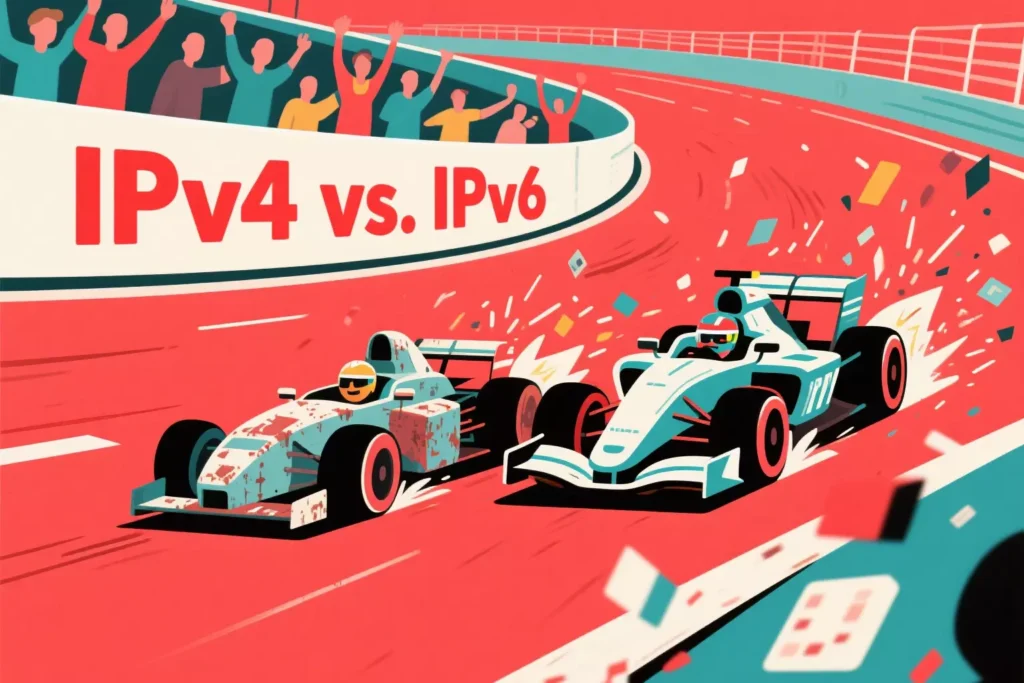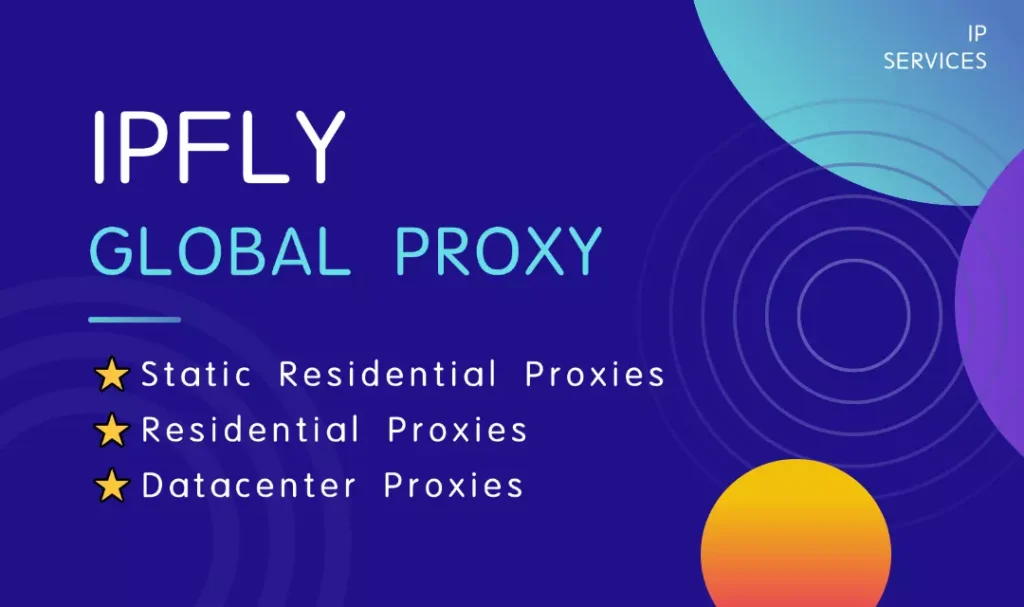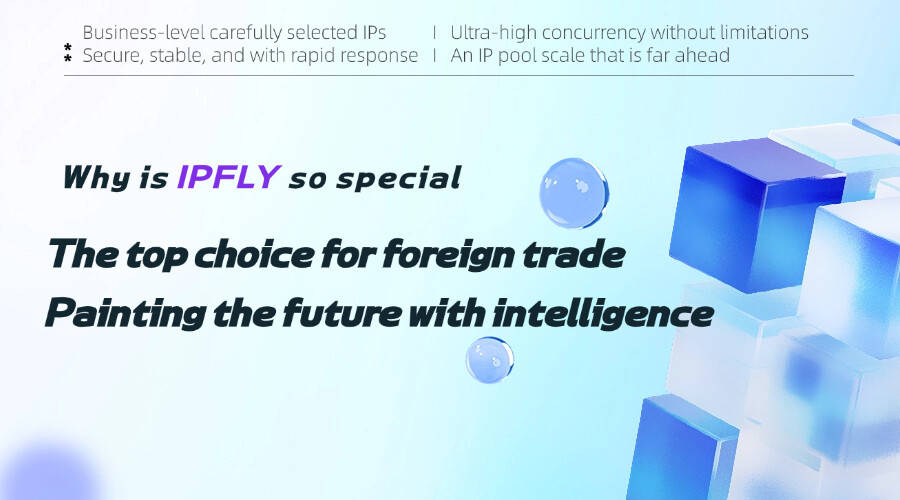Every device connected to the internet needs an IP address, but not all IPs are created equal. As the world moves deeper into the digital age, the debate of IPv4 vs. IPv6 becomes increasingly relevant—not just for IT professionals, but also for businesses, proxy users, and everyday internet users.
With the exhaustion of IPv4 addresses and the gradual transition to IPv6, it’s essential to understand the practical differences between the two. In this guide, we break down the fundamental contrasts, advantages, and limitations of each version, and explain what the shift means for proxy services like IPFLY and internet infrastructure as a whole.

What is IPv4?
IPv4 (Internet Protocol version 4) is the fourth version of the Internet Protocol and the most widely used. It was introduced in 1983 and provides a 32-bit address format, allowing for approximately 4.3 billion unique IP addresses.
An IPv4 address looks something like this: 192.168.1.1.
Key Characteristics:
- 32-bit numeric address
- Written in decimal, separated by dots
- Supports subnetting and NAT (Network Address Translation)
- Compatible with most legacy systems
Despite its reliability, IPv4 has one critical flaw—it’s running out of addresses. The surge of smartphones, smart devices, and cloud infrastructure has consumed a majority of available IPv4s, creating a global shortage.
What is IPv6?
IPv6 (Internet Protocol version 6) is the more modern version, developed by the Internet Engineering Task Force (IETF) in the late 1990s as a long-term solution to IPv4 limitations. It uses 128-bit addresses, which exponentially increases the available address pool—offering 340 undecillion IPs (that’s 340 followed by 36 zeros).
An IPv6 address looks like this: 2001:0db8:85a3:0000:0000:8a2e:0370:7334.
Key Characteristics:
- 128-bit hexadecimal address
- Written in colon-separated format
- Supports auto-configuration and mobility
- Eliminates the need for NAT
IPv6 is future-proof and was designed to enable seamless device communication, particularly important in the era of IoT and 5G.
IPv4 vs. IPv6: Key Differences at a Glance
| Feature | IPv4 | IPv6 |
| Address Length | 32 bits | 128 bits |
| Address Format | Decimal (e.g. 192.0.2.1) | Hexadecimal (e.g. 2001:db8::1) |
| Total Addresses | ~4.3 billion | ~340 undecillion |
| Header Complexity | Simple | More complex |
| NAT Support | Required | Not needed |
| Security | Optional (via IPSec) | Built-in support for IPSec |
| Compatibility | Legacy-friendly | Requires upgrades |
| Speed & Routing | Slower in some cases | Potential for faster routing |
Why Hasn’t IPv6 Fully Replaced IPv4?
Despite IPv6’s advantages, the transition hasn’t been quick or universal. Here’s why:
Cost of Migration: Upgrading entire systems—from routers to server software—requires significant investment.
Backward Compatibility: Many devices and applications still only support IPv4.
Limited Incentive for Enterprises: If businesses can still operate on IPv4, they often choose not to migrate.
Dual Stack Complexity: Running both IPv4 and IPv6 (dual-stack) requires maintenance and troubleshooting.
As a result, we live in a mixed world where both protocols coexist, and that creates complications—especially when it comes to proxy services, IP rotation, and geolocation management.
The Role of Proxies in the IPv4 vs. IPv6 Transition

Proxy providers like IPFLY operate across both IPv4 and IPv6 networks to support modern use cases including web scraping, ad verification, e-commerce monitoring, and SEO optimization.
IPv4 proxies are still the standard because most websites and online systems are built for IPv4. However, with the emergence of IPv6-enabled platforms and services, IPv6 proxies are gaining traction for users who need larger IP pools, better rotation, and faster connections.
Here’s how the two stack up in the context of proxy usage:
- IPv4 Proxies: Highly compatible, but more expensive due to scarcity.
- IPv6 Proxies: Cost-effective, faster rotation, but limited support on some websites.
At IPFLY, we maintain large pools of IPv4 and IPv6 addresses to ensure flexibility, high uptime, and precise targeting across different geolocations. This hybrid approach allows users to choose the right protocol for their application.
How the IP Shortage Fuels Proxy Demand
The shortage of IPv4 addresses has made them a hot commodity, especially in sectors like data scraping, ad tech, and automation. Businesses often rely on rotating IPs to prevent bans, bypass rate limits, or simulate users from various regions.
This demand fuels services like:
- Static residential proxies: Reliable IPs from real devices
- Dynamic residential proxies: Rotating, high-anonymity proxies
- Datacenter proxies: Fast, scalable, but easier to detect
IPFLY supports all three, giving businesses the tools to adapt, regardless of protocol.
Which IP Version Should You Choose?
It depends on your use case:
- General web access & scraping → Start with IPv4, unless blocked or limited.
- Large-scale automation or global targeting → Consider IPv6 for its size and speed.
- Enterprise SEO, fraud prevention, or e-commerce monitoring → Use hybrid stacks with dual support.
Forward-looking organizations are already preparing for an IPv6-dominant future, but IPv4 will remain relevant for years to come.
Final Thoughts
Understanding the differences between IPv4 and IPv6 is no longer just for IT professionals—it’s a business-critical insight. From resource allocation to proxy deployment and future scalability, the version of IP you use can affect speed, access, and cost.

At IPFLY, we’re committed to supporting both protocols with reliable infrastructure and flexible proxy solutions. Whether you’re operating in legacy environments or preparing for an IPv6-first world, our team ensures you’re always connected, secure, and scalable.


